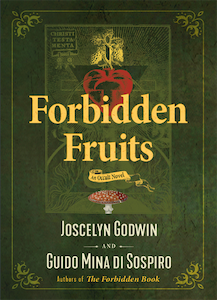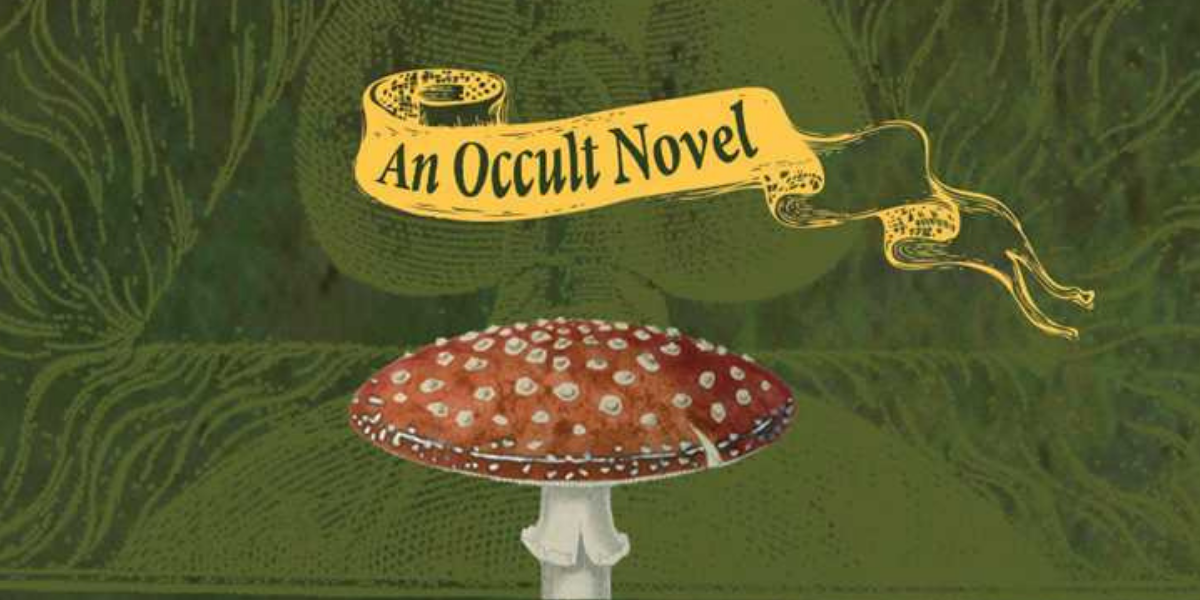
Forbidden Fruits: An Occult Novel, by Joscelyn Godwin and Guido Mina di Sospiro
Inner Traditions, 9781644111574, 288 pages, December 2020
What happens when Mexican Gothic crosses with The Da Vinci Code? You get the spellbinding novel, Forbidden Fruits: An Occult Novel by Josecelyn Godwin and Guido Mina di Sospiro. This thrilling mystery kept me guessing “who dun it” until the near end. I mean, a book that weaves together the magic of alchemy and entheogens, turning history on its head, in order to prevent the spread of evil in present times. Needless to say, I was hooked from the get-go and read the whole thing in 24-hours because I couldn’t put it down.
Godwin and di Sospiro have previously co-authored another book, titled The Forbidden Book. Keeping with the theme of forbidden, the authors continue to use their background to unveil information through fiction once again. Godwin has written extensively about spiritual connection fostered through music in his books which include Harmonies of Heaven and Earth, Cosmic Music, and Music, Mysticism & Magic . Di Sospiro also has a background in music as a classically trained guitarist, but is most well known for the short film he wrote and directed If I Could Do it all Over Again, I’d Do it All Over You. He’s also published the books Leeward and Windward, which also has an alchemical theme, and The Metaphysics of Ping-Pong, which focuses on philosophical topics.
I’ll admit I was a bit leery at the start of Forbidden Fruits that it would be too much of a thriller for my taste, as there are violent scenes interspersed throughout. However, the action scenes are tempered by plenty of nuanced character interaction and dialogue that keep the story intriguing from start to finish. While the plot is centered upon a murder mystery, which can easily become run of the mill, there were many distinguishing features that set this book apart from others.
To begin, the main character, Monica, is an archeologist who is funded by a very eccentric man named Sebastian. After years of searching, they have just happened upon an ancient find that has the potential to change the perception of history. However, this plot thread is only one of many. There’s also the oracle predictions warning an ancient secret society of evil on the island, neo-nazis who are wreaking havoc and murdering innocent people, and a huge immigration problem of Africans flocking to the coasts of Malta. With Sebastian being a noble and respected figure in Malta, he finds himself smack dab in the middle of the turmoil.
I won’t give away the climax of the book, but a turn of events forces Monica to team up with Sebsatian’s elusive son, Raphael to solve the case, all while assassins are out for them as well. There are endless twists and turns in the book that don’t come together until the very last pages of the book. I really enjoyed the variety of possible ways the story could go and watching the storm brew, wondering how things would play out.
There were many modern social justice issues raised, from the growth of hate groups to widespread immigration. While I am not very familiar with the current socio-political climate of Europe, specifically in Italy and Malta where the story takes place, I can see the current global trends happening in the United States as well with the rise of hate groups and human rights issues at the borders. The integration of present world problems heightened my ability to connect to the story, as I could easily understand and relate to the challenges the characters faced.
The best part about this book is how it incorporates alchemy, archeology, and entheogens into the plot. While there are countless stories of wizards, magicians, and occult societies dabbling in labs trying to find the Elixir of Life or the Philosopher’s Stone, I had never seen alchemy from the lens portrayed in Forbidden Fruits. Godwin and di Sospiro have done a wonderful job of illuminating the alchemy through Raphael and his journey to uncover the mysteries hidden within; readers get to experience firsthand the character’s perspective of ritually consuming the sacred soma.
Alchemical drawings and apocalyptic texts sprung to life when viewed from the perspective of entheogen consumption. Godwin and di Sospiro create a whole new paradigm through which to understand Jesus Christ’s message and the words of the Bible by linking it to the ritual consumption of entheogens. While Carl Jung’s Red Book never seemed much more than imaginal pictures to me, I suddenly understood through the writing of the authors how these images can in fact truly mirror archetypal energies.
In our technologically and secular world, the idea of demons and maleficent forces seem arcane. However, reading Forbidden Fruits spurred on my investigation into demonology, helping me to see the value in knowing these energies that could potentially still be within the world. By blending the supernatural with occult knowledge, I feel as though Godwin and di Sospiro elucidated the value of alchemy, beyond the personal plight of truth, knowledge, and life essence often perpetuated in the mythos.
What I enjoyed the most was the humility of the alchemists. With trust in their order and dedication to the natural law, one’s station in life was not as important as the legacy of the alchemical wisdom they protect. With the rise in conspiracy theories, secret societies seem to be all the rage in popular culture, and often to the detriment of these sacred orders. I appreciated there was no self-effacement on the order’s part to assert their will, but rather they used their tools to assist the protagonist Raphael in his own mission quite discreetly. Forbidden Fruits accurately captures the true nature of the groups that protect esoteric knowledge with dignity, respect, and loyalty — a concept that could use some reviving in modern times.
I highly recommend Forbidden Fruits to anyone looking for a good mystery novel, especially if you have an interest in the occult. Godwin and di Sospora have created an illuminating novel that makes the reader question the true nature of Christianity, while also demonstrating and offering insight into how the use of entheogens may be one of the oldest sacred rituals. The characters ultimately must decide for themselves how far they are willing to go to find the truth, and following along in their journey is absolutely fascinating.
Alanna Kali is an astrologer, numerologist, and pioneer spirit that loves to explore life through the lens of depth psychology. She has a passion for studying the humanities and social trends. Her academic work is centered upon reuniting body, mind, and spirit through eco-psychology. She loves reading, spending time in nature, and travel.
